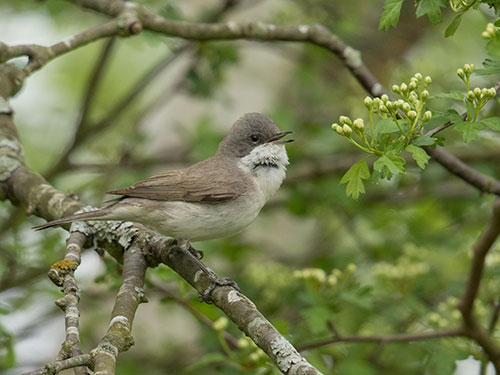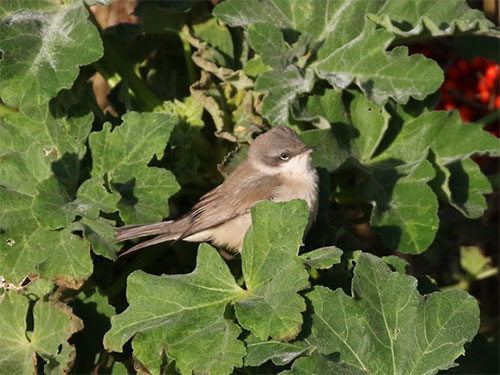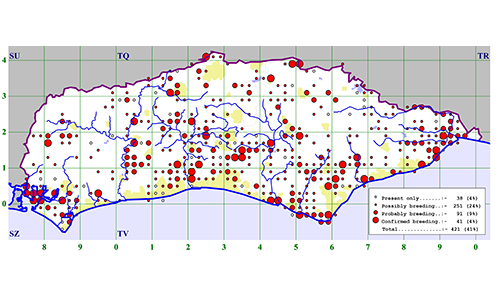


Lesser Whitethroat, Pulborough Brooks, 28 April 2019.
Photo: Gary Faulkner

‘blythi’ Lesser Whitethroat, Birling Gap, 28 October 2019.
Photo: Laurence Pitcher

Lesser Whitethroat, Sussex Bird Atlas, 2008-11
The Lesser Whitethroat is a summer visitor to Sussex, but is easily overlooked, so unless you are a keen birdwatcher, you may not have seen one. It is smaller, scarcer and less obtrusive than the Common Whitethroat Curruca communis. One reason why it is harder to see in Sussex is that it prefers tall hedgerows and scrub within farmland, a much less widespread habitat than the low farm hedges preferred by Common Whitethroats. Indeed, the 2008-11 breeding distribution atlas for Sussex shows large gaps in the Lesser Whitethroat’s range.
The species is rather plain in colour, lacking the rich rusty-brown in the wing of the Common Whitethroat, another reason why they are easy to miss. The sexes look the same: earth-brown above with a grey head sharply set off from the white throat and greyish-white underparts. Some individuals have pale ‘spectacles’. The males tend to sing from within cover, so will often be overlooked unless the observer is familiar with the quite loud, but repetitive rattle, which is preceded by a short quieter and scratchy warble. Because of these behavioural, plumage and habitat traits, the species is probably under-recorded in our county. During local walks in the spring 2020 lockdown, I found singing males at a new site less than two miles from my home in Haywards Heath, where I had never suspected their presence. The local farmer had carefully managed the hedges so that they were unusually tall and vigorous, which made all the difference.
Compared to other warblers that are summer visitors to Britain, Lesser Whitethroats have a very different migration route. They arrive here in April having flown from north-east Africa and by August the return migration is underway, the birds heading back south-east, not taking the more southerly route to Africa adopted by other warbler species.
Occasionally, a Lesser Whitethroat will appear very late in the autumn in Sussex, or even take up residence in a garden in winter. It is probable that these individuals are vagrants of one of the eastern races that breed in Siberia and usually winter in South Asia. Indeed, two birds of the Siberian race ‘blythi’ have been detected using DNA analysis, one at Pett Level on 8th November 2018 and another at Birling Gap between 27th October and 6th November 2019. Such eastern birds are very hard and sometimes impossible to identify in the field.
If you put fat and sunflowers hearts in your garden next autumn and winter to attract wintering Blackcaps Sylvia atricapilla, keep and eye out for one of these rarer warblers. Ahead of that, listen to a recording of the Lesser Whitethroat’s song, easily found online, for example at https://www.xeno-canto.org/species/Sylvia-curruca and search this spring for this hard to see but characterful little bird, making sure that the habitat looks suitable.
Mark Mallalieu
mallalieum@gmail.com
Every month it is our aim to highlight a species that is “in-season” and, although not necessarily rare or difficult to identify, has been highlighted by our local recording groups as being somewhat under-recorded and for which new records would therefore be welcomed.
If you or your recording group are aware of species such as this then please contact Bob Foreman.